Picture yourself nestled in a snow-draped forest, where crystalline silence is broken only by the crackle of your campfire and the whisper of winter winds through towering pines. Winter camping in Canada isn’t just an adventure – it’s a masterclass in embracing nature’s most challenging season. While summer campers crowd popular sites, winter offers solitude seekers pristine landscapes and exclusive wildlife encounters, from snow-dusted moose tracks to the haunting calls of great horned owls.
Yet this serene experience demands respect and preparation. Canadian winters transform familiar trails into dramatic snowscapes where temperatures can plummet to -30°C (-22°F), turning simple tasks into strategic decisions. But with proper gear, knowledge, and planning, winter camping reveals Canada’s wild spaces at their most magnificent – when aurora borealis paints the sky and fresh powder blankets the wilderness in hushed splendor.
Whether you’re a seasoned outdoor enthusiast looking to extend your camping season or an adventure seeker ready to embrace the extraordinary, this guide will equip you with essential knowledge for safe and memorable winter camping experiences in Canada’s breathtaking backcountry.
Preparing for Your Ontario Winter Camping Adventure
Winter-Ready Gear Essentials
Getting your gear right is crucial for a comfortable winter camping experience. Let’s break down the winter camping essentials you’ll need to stay warm and safe in Canada’s chilly wilderness.
Start with your base layer – merino wool or synthetic thermal underwear is your best friend. Layer up with insulating fleece and top it off with a waterproof, breathable outer shell. Don’t forget your extremities: pack moisture-wicking socks (bring extras!), insulated winter boots rated for -40°C, and both thin liner gloves and heavy mittens.
For sleeping gear, invest in a four-season tent and a winter-rated sleeping bag (preferably -30°C or lower). Pro tip: stuff your sleeping bag into a dry bag during the day to prevent moisture buildup. A closed-cell foam pad topped with an inflatable sleeping pad provides crucial insulation from the frozen ground.
Essential tools include a reliable camp stove that performs well in cold temperatures (liquid fuel stoves are best), a snow shovel, and plenty of matches in waterproof containers. Pack a headlamp with extra batteries – winter nights are long! Don’t forget your insulated water bottles and a thermos for hot drinks.
Remember to bring emergency gear like a first-aid kit, emergency blanket, and fire starters. These might seem like extras, but in winter conditions, they’re absolute necessities.
Choosing Your Winter Campsite
Selecting the perfect winter campsite can make or break your cold-weather adventure in Ontario’s stunning parks. Start by looking for natural windbreaks like dense evergreen stands or rock formations that’ll shield your tent from bitter gusts. The sweet spot is finding higher ground that’s still protected – this prevents cold air from pooling around your campsite and helps avoid any surprise water accumulation from melting snow.
Look for spots that catch the morning sun but offer afternoon shade. This natural alarm clock will warm your tent at dawn while preventing snow from turning into slush later in the day. Before setting up, thoroughly pack down the snow where you’ll pitch your tent. This creates a solid platform and prevents your body heat from melting the snow underneath, keeping you dry throughout the night.
Stay clear of avalanche-prone areas and avoid camping directly under snow-laden tree branches. These snow bombs can give you an unwelcome wake-up call! If you’re new to winter camping, choose sites closer to park facilities or marked trails – it’s always good to have a backup plan.
Many Ontario parks offer designated winter camping areas with amenities like woodlots and sheltered cooking spaces. Algonquin Park and Killarney Provincial Park are fantastic for beginners, with well-maintained winter sites and marked trails nearby. Remember to check park websites for current conditions and availability before heading out.
Pro tip: Pack down a separate cooking area and create paths between your tent, kitchen, and other essential spots – you’ll thank yourself later when moving around in the dark!
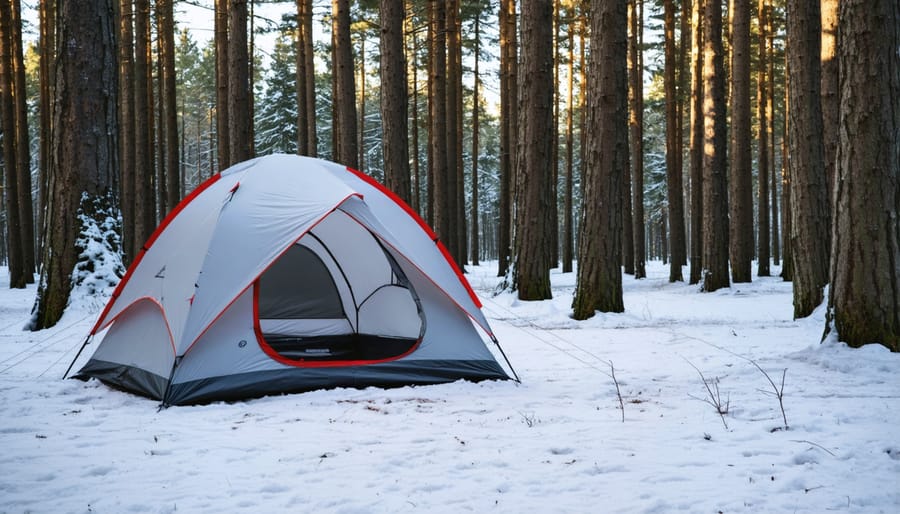
Top Winter Camping Destinations in Ontario Parks
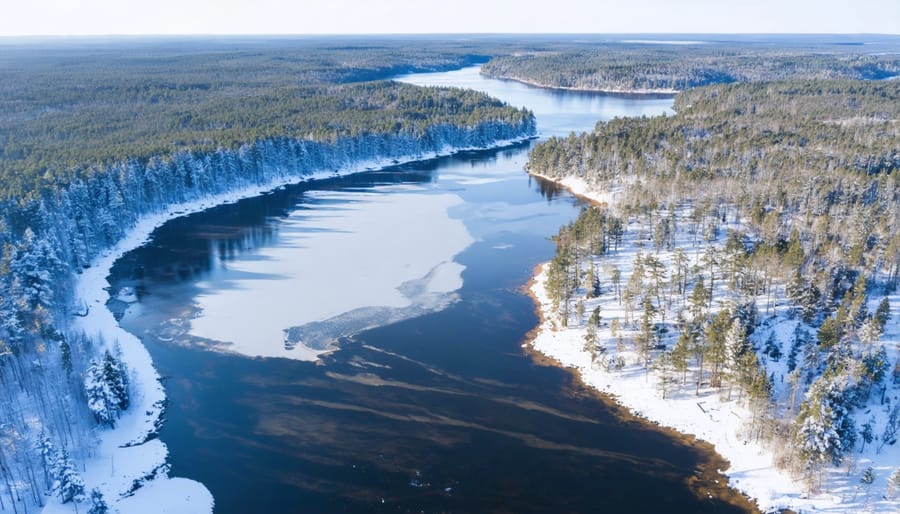
Algonquin Provincial Park
Nestled in the heart of Ontario, Algonquin Provincial Park transforms into a winter wonderland that offers some of the most memorable camping experiences in Canada. The park maintains several winter camping areas, with Mew Lake Campground being the only drive-in option available year-round. Here, you’ll find electrical sites, comfort stations with hot showers, and heated washrooms – perfect for those new to winter camping.
For the more adventurous souls, the park’s backcountry presents an untouched winter paradise. You can access remote camping spots via cross-country skiing or snowshoeing along the park’s extensive trail network. The Western Uplands, Highland, and Eastern Pines backpacking trails remain open throughout winter, offering solitude and pristine snow-covered landscapes.
Winter campers can expect to spot wildlife like moose, wolves, and various winter birds, making wildlife viewing particularly rewarding during these quieter months. The park’s visitor center remains open year-round, providing crucial information about trail conditions, weather updates, and safety guidelines.
Pro tip: Book your Mew Lake site in advance during winter weekends and holidays, as it’s becoming increasingly popular among winter camping enthusiasts. For a truly unique experience, consider staying in one of the park’s heated yurts – a cozy alternative to traditional winter camping that still allows you to immerse yourself in the winter wilderness.
Remember to practice “leave no trace” principles and properly store your food to avoid attracting wildlife. The park staff regularly maintain winter facilities and trails, ensuring a safe and enjoyable experience for all visitors.
Killarney Provincial Park
Nestled in Ontario’s rugged wilderness, Killarney Provincial Park transforms into a winter wonderland that beckons adventurous campers seeking solitude and pristine landscapes. The park’s iconic white quartzite ridges of the La Cloche Mountains, dusted with snow, create a breathtaking backdrop for winter camping enthusiasts.
The park offers six year-round yurts at the George Lake Campground, providing a perfect balance between comfort and wilderness experience. Each heated yurt comes equipped with basic furniture, making it an excellent option for those new to winter camping or seeking a more comfortable experience. However, for the true wilderness enthusiast, backcountry camping sites are available throughout the park’s 645 square kilometers.
Winter activities abound in Killarney, with over 33 kilometers of groomed cross-country ski trails varying from beginner to advanced levels. The park’s frozen lakes offer excellent opportunities for ice fishing, while snowshoeing adventures allow you to explore untouched terrain and spot wildlife like snowshoe hares, wolves, and moose.
Pro tip: Book your yurt well in advance, as they’re incredibly popular during winter months. For backcountry camping, check in at the park office for current conditions and obtain necessary permits. The staff can provide valuable insights about trail conditions and weather forecasts.
Remember to pack extra layers and emergency supplies, as temperatures can drop significantly at night. The park’s remote location means limited cell service, so proper preparation is essential. Consider bringing a winter-rated sleeping bag, portable stove, and plenty of high-energy snacks to fuel your adventures in this pristine winter paradise.
Safety and Survival Tips
Cold Weather Safety
When temperatures plummet in the Canadian wilderness, staying warm while winter camping becomes your top priority. The key to a safe winter camping experience is layering your clothing properly – think of it as wearing your sleeping bag! Start with a moisture-wicking base layer, add an insulating middle layer, and top it off with a weatherproof shell.
Keep a close eye on everyone in your group for signs of hypothermia, such as intense shivering, confusion, or slurred speech. If you notice these symptoms, immediately get the person into dry clothes and warm them gradually. Hot drinks and high-energy snacks can help maintain body heat, so keep these readily available.
One of my favorite tricks is to fill a water bottle with hot water and pop it into your sleeping bag before bedtime. This creates a cozy microclimate that’ll keep you toasty through the night. Remember to stay dry at all costs – sweating can be dangerous in cold weather, so adjust your layers to prevent overheating during activities.
Never underestimate the importance of proper gear. Insulated sleeping pads are non-negotiable, as the cold ground can steal your body heat faster than the air. Keep emergency supplies like hand warmers, an extra set of dry clothes, and a reliable fire starter in a waterproof container. When nature calls at night, don’t hold it in – a full bladder uses extra energy to keep that liquid warm!
Emergency Preparedness
When winter camping in Canada’s wilderness, being prepared for emergencies isn’t just smart – it’s essential. Always pack a well-stocked first aid kit with extra supplies for winter-specific injuries like frostbite and hypothermia. Include emergency blankets, hand warmers, and a reliable communication device like a satellite phone or emergency beacon, as cell service can be spotty in remote areas.
Before heading out, leave a detailed trip plan with a trusted friend or family member, including your intended route, campsite locations, and expected return date. Pack emergency shelter materials like an extra tarp or lightweight tent, even if you’re planning to stay in a cabin or yurt. A reliable fire starter kit with waterproof matches, a lighter, and fire starters is crucial – I always pack mine in a waterproof container with extras spread across different bags.
Keep an emergency food and water supply separate from your regular provisions. High-calorie, non-perishable foods like energy bars and dried fruits can be lifesavers. Don’t forget basic repair tools for equipment and a multi-tool – you’d be surprised how often these come in handy!
One of my favorite safety tips: practice setting up emergency shelter and starting fires in cold conditions before your trip. These skills feel very different when your hands are cold and daylight is fading. Remember, in winter conditions, staying warm and dry is your top priority in any emergency situation.
Winter Activities and Adventures
Daytime Activities
Winter camping in Canada isn’t just about cozying up in your tent – the daytime hours offer incredible opportunities for adventure and exploration. Snowshoeing is perhaps the most accessible winter activity, allowing you to float effortlessly across deep snow while exploring silent forest trails. Many campgrounds offer snowshoe rentals and marked trails perfect for beginners.
Cross-country skiing provides another fantastic way to cover more ground and get your heart pumping. Gliding through snow-covered landscapes, you’ll discover hidden valleys and frozen lakes that feel worlds away from civilization. Pack a thermos of hot chocolate and some trail mix for a memorable wilderness picnic along the way.
Wildlife viewing takes on a special magic during winter months. Keep your eyes peeled for snow-white snowshoe hares, red foxes against the pristine snow, and the majestic moose foraging in winter yards. Early mornings often provide the best opportunities to spot animals, when they’re most active and the light is perfect for photography.
Pro tip: Many species leave distinctive tracks in the snow, making winter an excellent time for animal tracking. Bring a pocket guide to help identify different prints, and you’ll start reading the story of the forest’s nighttime activities. Remember to maintain a respectful distance from any wildlife you encounter, and never feed or approach wild animals.
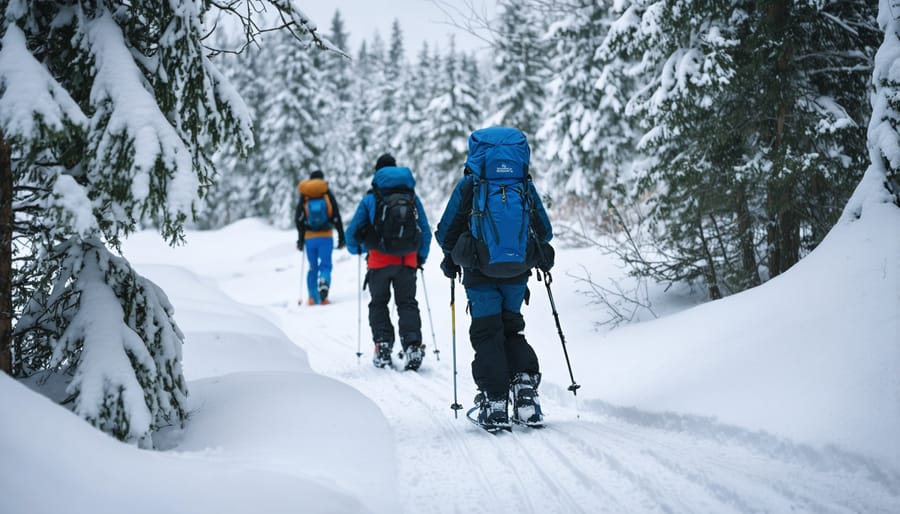
Evening Entertainment
As the winter sun sets early, the Canadian wilderness transforms into a magical nighttime playground. Bundle up and venture outside your tent to witness one of nature’s most spectacular shows – the crystal-clear winter night sky. Away from city lights, you’ll be treated to an extraordinary display of stars, and if you’re lucky, you might catch the mesmerizing Northern Lights dancing above.
Gather around your carefully maintained campfire (remember to collect firewood before dark) for traditional winter camping entertainment. Share stories, roast marshmallows, or prepare hot chocolate to stay cozy. Pro tip: bring fire starters and dry kindling in a waterproof container to ensure your evening fire lights easily in snowy conditions.
For group activities, pack a deck of cards or compact board games that work well by lantern light. Photography enthusiasts will love capturing long-exposure shots of the starry sky or experimenting with light painting using headlamps. Consider bringing a star chart or downloading a stargazing app to identify constellations – winter offers some of the clearest viewing conditions of the year.
Before settling in for the night, take a short evening walk around your campsite. The wilderness comes alive differently after dark, with the soft crunch of snow beneath your boots and the occasional call of a night bird. Just remember to stay on marked trails and carry a reliable light source.
Remember that winter nights are long, so pace your evening activities and turn in early to stay warm and energized for the next day’s adventures.
Winter camping in Canada’s pristine wilderness is truly a transformative experience that connects you with nature in its most magnificent form. The pristine snow-covered landscapes, the absolute tranquility, and the sense of accomplishment you feel after mastering winter camping skills make it all worthwhile. While it requires careful preparation and respect for the elements, the rewards are immeasurable – from witnessing the Northern Lights dance across the sky to waking up to a fresh blanket of snow outside your tent.
Don’t let the cold deter you from experiencing this incredible adventure. With proper gear, knowledge, and a positive attitude, you’ll discover a whole new side of Canada that many never get to see. So pack your winter gear, gather your camping buddies, and embrace the extraordinary beauty of Canadian winters in the great outdoors. The memories you’ll make will last a lifetime, and the stories you’ll tell will inspire others to follow in your snowshoe tracks.


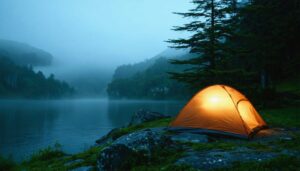




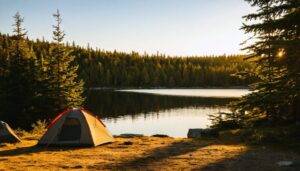
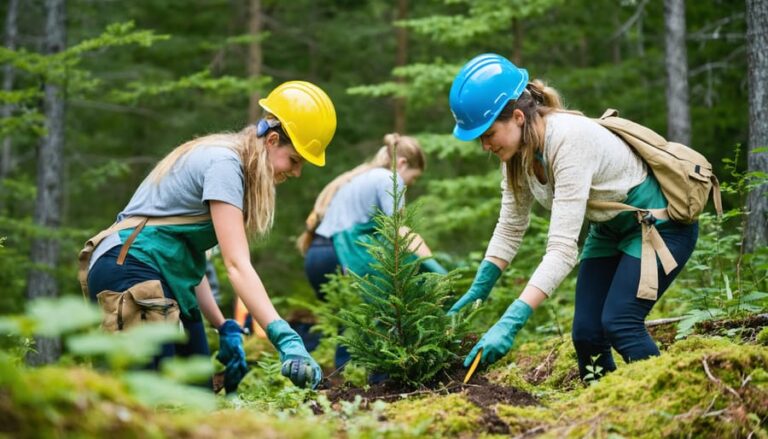
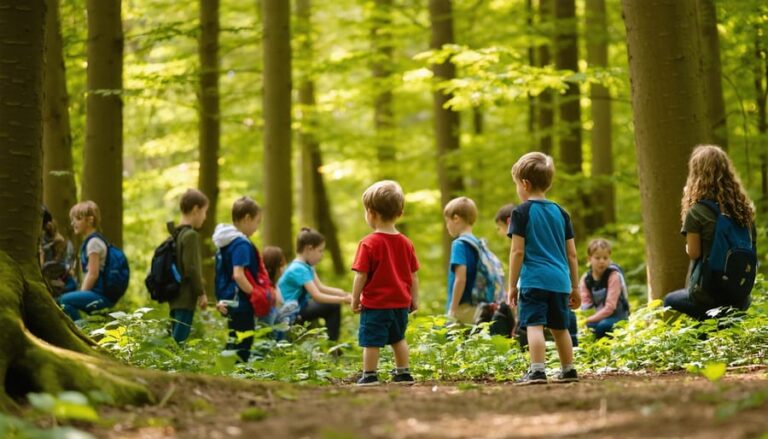
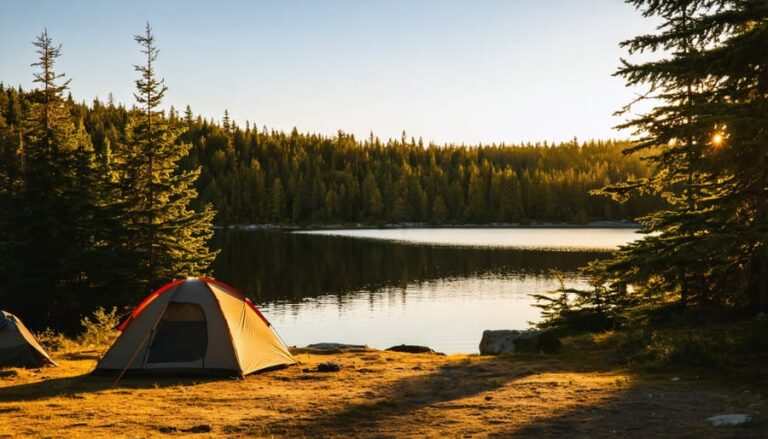
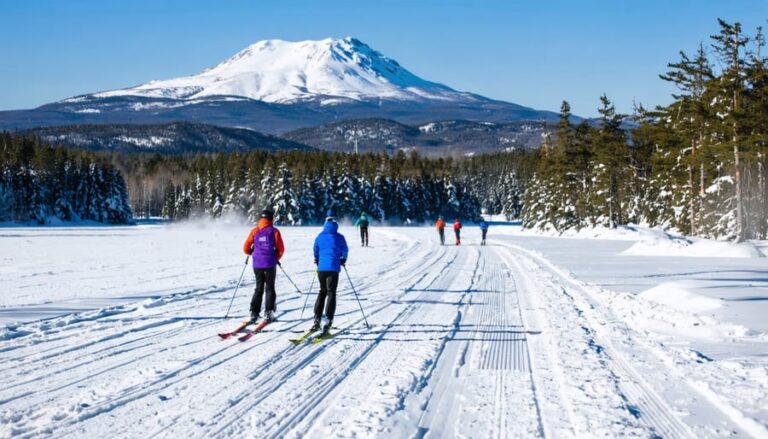

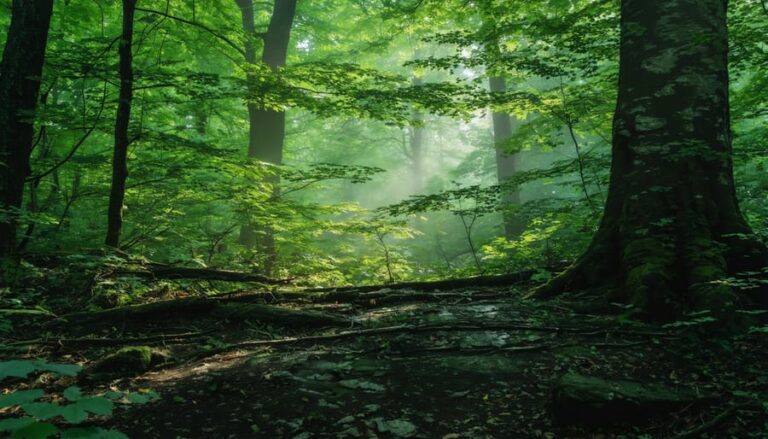
+ There are no comments
Add yours